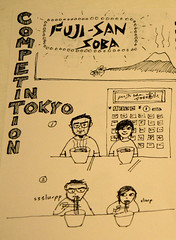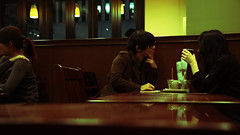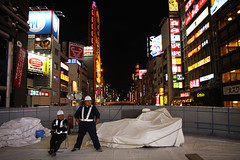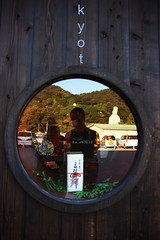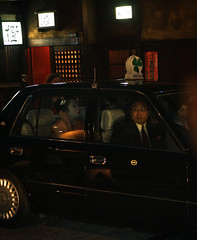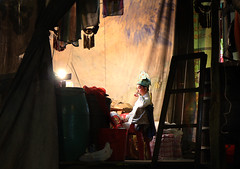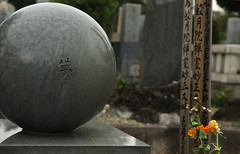
all images, except this, by J
The walls of ancient cities mark their boundaries and serve to control traders, aliens, intruders and disease. Today's cities are marked instead by their porosity. They boast not of limits, but of - to use our island's governmentspeak - "possibilities" (or the super cringe-worthy "possibicities").
Maybe today's city walls are represented instead by our museum and gallery walls. While these walls face inward, they invite instead of deny and repel. They close off a room, but open up imaginative spaces and physical spaces for not only inhabitants of the city but all kinds of folks to question, critique, demand, contemplate, play. These walls hold up for its inhabitants and visitors to view the strength of a city's financial and intellectual currency with the world, its ability to talk above its domestic noise, and its vitality.
In fact, a mark of cities that are deemed to have arrived is that their museums and galleries are must-sees. So if you are in Tokyo, us amps recommend these art museums/galleries that we saw:
(1) The Mori Arts Centre on the 53rd flr of Mori's Roponggi Hills development. [Y1,500 for a combined ticket to the gallery & city view]
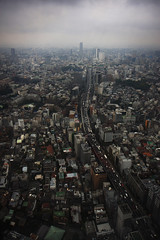
View just below the 53rd Flr Mori Art Centre
It is not a conventional gallery or museum in the sense that there is no permanent collection to speak of. When we were there, the gallery was showing the 2nd "Roponggi Crossings" (the first was in 2004). The team of curators had chosen artists whom they had produced the most exciting work and reflected the future of Japanese contemporary art. Another common idea was that of working across disciplines or having made some form of crossover. Hence there were artists who also produced manga, collaborated with musicians, or started in the field of photography or as an ironsmith! Visitors could vote for the most impactful work. Both J and I - aiyah, soulmates mah! - chose the same artist - a photographer who had taken these nightmarish yet strangely alluring shots of underground Tokyo and animals in test labs.
(2) Suntory Museum of Art at the Tokyo Midtown development. [ Y1,300 for entry]
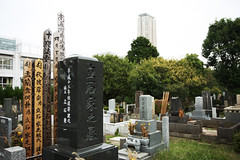
tombuildings
(Enroute to Tokyo Midtown, we were distracted by the large peaceful cemetary grounds right in the middle of fashionable Aoyama. It's worth a restful 30min stroll. To get there, exit the Aoyama Itochome station, it is a 10min walk. You can spot the cemetary on the map outside the station. These marble obelisks of varying sizes and age are just like the buildings in the background, or should I compare instead the buildings of the cityscape to these tombstones?)
It's a small and elegant 2 storey corporate gallery in the new Tokyo Midtown development. The show it had on then was on these old Japanese screens. Not quite stuff we are normally excited about, but the pieces were exquisitely made and preserved. Suntory has another museum by the Osaka Harbour (there are tons of corporate galleries in Tokyo, such as the Shiseido Gallery, the Seibu Gallery, Parco Gallery, many of which had launched artists' careers. Ah why won't our Temasek Holdings or SIA, please, start a corporate collection and gallery? Even Korea's Samsung has, that's another mark of a nation!). The Suntory Museum is worth a 45min visit if it's the only thing in the upmarket Tokyo Midtownthat you can afford! There were troops of middle-aged Japanese visitors when we were there.
(3) The 21-21 Design Sight designed by Tadao Ando and buried in the garden of Tokyo Midtown [ Y2,000 for entry]

21-21 Design Sight by Tadao Ando right beside the Tokyo Midtown
When we were there, 21-21 Design Sight was showing a brilliantly curated, thought-provoking, engaging and enjoyable exhibition on "Water", presenting installations that interpreted this resource - its qualities, its forms in the landscape and weather, its textures and sounds, our memories and imagined experiences. The entry ticket was costly, but worth every yen.
(4) The new National Art Centre Tokyo (NACT) designed by the late Kurokawa 5min away from Tokyo Midtown

Kurokawa had passed away a week or so before we visited this museum. A few nights ago, we had also watched a documentary (probably a special re-run) of Kurokawa travelling somewhere in Eastern Europe (or was it Russia?) re-visiting an old friend and speaking about the architectural works in that city. We did not know then that he had just died. The NACT had several shows running concurrently - one on Vermeer, one showcasing 100 years of Nitten (a government-sponsored art competition that probably represented a particularly conventional and staid strain still present), and one of photographs by Shigeo Anzai. All the exhibitions were individually ticketed.
We caught the exhibition of Shigeo Anzai's (a ticket was Y1100, with a Y200 discount if you showed the stub for the Suntory Museum) photographs of various artists and their works/shows from the 1970s till today. It was chronologically presented, with photographs tacked on the walls organised as a timeline. No fancy curation - but as a document of documentation, it was apt and showed the sheer breadth and development of Japanese contemporary art.
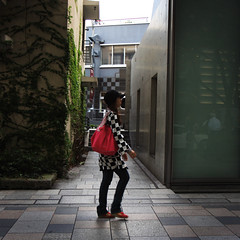
The Omotesando Hills development and fashionable crowd are part of the pervasive art - spot the pattern!
But what amazed me was (not unlike the Suntory Museum) the crowds that were present at the museum. It was a weekday afternoon, and even when we left at 6pm, with us was a group of about 100 visitors who had remained in the museum till closing time.
Hmmm. I know this is a vacation, but these visits to the various galleries and museums naturally led me to think about work and our tropical island 7 hours away by plane. What do our museums and galleries mean to us?
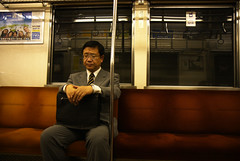
Tired salaried folks are the same everywhere in the world.
========
P/S. If you have the time, the Museum of Contemporary Art Tokyo is also well worth a visit. It is located beside Kiba park, which is a 30-45min train ride away from places like Shibuya. We were there 4 years and had gone there again this time, only to discover that it was shut for the installation of a new show on art and design due to open the next day!

